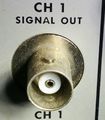BNC connector: Difference between revisions
No edit summary |
No edit summary |
||
| Line 2: | Line 2: | ||
'''BNC''' (from ''Bayonet Neill–Concelman'', sometimes erroneously referred to as the ''Bayonet Naval Connector'' or the ''Baby N Connector'') is the most common coaxial connector standard for measurement equipment up to 1 GHz. | '''BNC''' (from ''Bayonet Neill–Concelman'', sometimes erroneously referred to as the ''Bayonet Naval Connector'' or the ''Baby N Connector'') is the most common coaxial connector standard for measurement equipment up to 1 GHz. | ||
Patented in 1951 by Hazeltine Research, Inc, it is available in different impedances, with 50 Ω being by far the most common. | |||
A 75 Ω variant is often used in applications related to video signals, a 93 Ω version was historically used in some data communication applications ([[wikipedia:ARCnet|ARCnet]], [[wikipedia:IBM 3270|IBM 3270]]). These versions differ in the sizes of the dielectric parts (see photos below). | |||
Tektronix gear transitioned from [[UHF connector]]s to BNC connectors in | Tektronix gear transitioned from [[UHF connector]]s to BNC connectors in the early to mid-1960s. | ||
the early to mid- | For some pieces of equipment, a conversion kit was available. | ||
available. [[Media: | |||
[[Media:Service Scope 23 Dec 1963.pdf|Service Scope Number 23]] (December 1963) explains: | |||
<blockquote> | <blockquote> | ||
Recently, Tektronix, Inc. made the decision to convert all Tektronix instruments having UHF connectors to BNC connectors and, also, that Tektronix instruments of future design will employ BNC connectors. | Recently, Tektronix, Inc. made the decision to convert all Tektronix instruments having UHF connectors to BNC connectors and, | ||
also, that Tektronix instruments of future design will employ BNC connectors. | |||
The decision to convert the Tektronix product line to BNC connectors was based on the following facts: | The decision to convert the Tektronix product line to BNC connectors was based on the following facts: | ||
# BNC connectors offer lower input capacitance | # BNC connectors offer lower input capacitance – an extremely important consideration in some applications. | ||
# BNC connectors have the requirements demanded by high-frequency instruments for good performance. | # BNC connectors have the requirements demanded by high-frequency instruments for good performance. | ||
# BNC connectors require less panel space and provide more finger room. Growing panel-density problems dictate their use. | # BNC connectors require less panel space and provide more finger room. Growing panel-density problems dictate their use. | ||
| Line 20: | Line 23: | ||
==Links== | ==Links== | ||
* [ | * [[wikipedia:BNC connector|BNC connector]] @ Wikipedia | ||
* [[Patent US 2540012A|BNC Connector Patent]] | * [[Patent US 2540012A|BNC Connector Patent]] | ||
| Line 26: | Line 29: | ||
<gallery> | <gallery> | ||
Bnc female.jpg|BNC Female | Bnc female.jpg | 50 Ω BNC Female | ||
Bnc male.jpg|BNC Male | Bnc male.jpg | 50 Ω BNC Male | ||
BNC 50 vs 75 ohms.jpg | 50 Ω (top) vs 75 Ω (bottom) BNC plugs | |||
Cross section of a 50 ohm and 75 ohm BNC mated pair.png | Cross section of a 50 Ω (bottom) and 75 Ω (top) BNC mated pair | |||
</gallery> | </gallery> | ||
[[Category:Coaxial connectors]] | [[Category:Coaxial connectors]] | ||
[[Category:Probe interfaces]] | [[Category:Probe interfaces]] | ||
Latest revision as of 04:41, 16 October 2024

BNC (from Bayonet Neill–Concelman, sometimes erroneously referred to as the Bayonet Naval Connector or the Baby N Connector) is the most common coaxial connector standard for measurement equipment up to 1 GHz.
Patented in 1951 by Hazeltine Research, Inc, it is available in different impedances, with 50 Ω being by far the most common. A 75 Ω variant is often used in applications related to video signals, a 93 Ω version was historically used in some data communication applications (ARCnet, IBM 3270). These versions differ in the sizes of the dielectric parts (see photos below).
Tektronix gear transitioned from UHF connectors to BNC connectors in the early to mid-1960s. For some pieces of equipment, a conversion kit was available.
Service Scope Number 23 (December 1963) explains:
Recently, Tektronix, Inc. made the decision to convert all Tektronix instruments having UHF connectors to BNC connectors and, also, that Tektronix instruments of future design will employ BNC connectors.
The decision to convert the Tektronix product line to BNC connectors was based on the following facts:
- BNC connectors offer lower input capacitance – an extremely important consideration in some applications.
- BNC connectors have the requirements demanded by high-frequency instruments for good performance.
- BNC connectors require less panel space and provide more finger room. Growing panel-density problems dictate their use.
- BNC connectors are employed by the majority of manufacturers producing instruments used in conjunction with oscilloscopes.
- BNC connectors are quicker and easier to connect and disconnect.
Links
- BNC connector @ Wikipedia
- BNC Connector Patent
Pictures
-
50 Ω BNC Female
-
50 Ω BNC Male
-
50 Ω (top) vs 75 Ω (bottom) BNC plugs
-
Cross section of a 50 Ω (bottom) and 75 Ω (top) BNC mated pair



